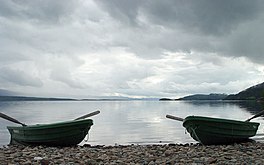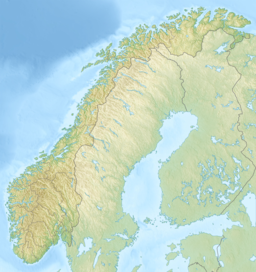Snåsavatnet
| Snåsavatnet | |
|---|---|
 | |
| Location | Steinkjer and Snåsa, Trøndelag |
| Coordinates | 64°11′15″N 12°01′30″E / 64.1874°N 12.0249°E |
| Type | glacier fjord lake |
| Primary outflows | Byaelva |
| Catchment area | 1,434.24 km2 (553.76 sq mi) |
| Basin countries | Norway |
| Max. length | 40 km (25 mi) |
| Max. width | 5 km (3.1 mi) |
| Surface area | 125.73 km2 (48.54 sq mi) |
| Average depth | 46 m (151 ft) |
| Max. depth | 186 m (610 ft) |
| Water volume | 5.78 km3 (1.39 cu mi) |
| Surface elevation | 22 m (72 ft) |
| References | NVE |
Snåsavatnet (Urban East Norwegian: [ˈsnòːsɑˌvɑtnə]; English: Lake Snåsa) is Norway's sixth-largest lake. The 126-square-kilometre (49 sq mi)[1] lake is located in the municipalities of Steinkjer and Snåsa in Trøndelag county, Norway. The villages of Følling and Sunnan lie at the southwestern end of the lake and the village of Snåsa lies at the northeastern end of the lake. European route E6 runs along the northern shore of the lake and the Nordland Line runs along the southern shore.
The lake is approximately 40 km (25 mi) long and on average about 3 km (1.9 mi) wide. The surface of the lake is only 22 m (72 ft) above sea level, and it reaches depths of up to 186 m (610 ft). Its deepest area reaches; 164 m (538 ft) below sealevel. The lake was created by glacial erosion. As it is seen on a map, the lake looks like an extension of the Trondheim Fjord. The outlet is the river Byaelva, which empties into the Beitstadfjorden (an arm of the Trondheim Fjord) in the city of Steinkjer.[2]
See also[edit]
References[edit]
- ^ "Statistisk årbok 2009: Geografisk oversikt" (in Norwegian). Ssb.no. Retrieved 2019-05-15.
- ^ Rosvold, Knut A., ed. (2018-02-06). "Snåsavatnet". Store norske leksikon (in Norwegian). Kunnskapsforlaget. Retrieved 2018-04-07.


